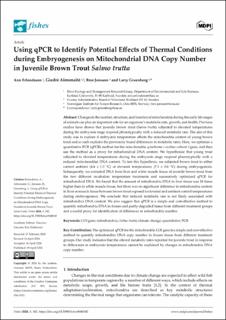| dc.contributor.author | Erlandsson, Ann | |
| dc.contributor.author | Ašmonaitė, Giedrė | |
| dc.contributor.author | Jonsson, Bror | |
| dc.contributor.author | Greenberg, Larry | |
| dc.date.accessioned | 2024-04-24T12:31:55Z | |
| dc.date.available | 2024-04-24T12:31:55Z | |
| dc.date.created | 2024-04-22T08:54:33Z | |
| dc.date.issued | 2024 | |
| dc.identifier.issn | 2410-3888 | |
| dc.identifier.uri | https://hdl.handle.net/11250/3127950 | |
| dc.description.abstract | Changes in the number, structure, and function of mitochondria during the early life stages of animals can play an important role for an organism’s metabolic rate, growth, and health. Previous studies have shown that juvenile brown trout (Salmo trua) subjected to elevated temperatures during the embryonic stage respond phenotypically with a reduced metabolic rate. The aim of this study was to explore if embryonic temperature affects the mitochondria content of young brown trout and as such explains the previously found differences in metabolic rates. Here, we optimize a quantitative PCR (qPCR) method for the mitochondria cytochrome c oxidase subunit I gene, and then use the method as a proxy for mitochondrial DNA content. We hypothesize that young trout subjected to elevated temperatures during the embryonic stage respond phenotypically with a reduced mitochondrial DNA content. To test this hypothesis, we subjected brown trout to either control ambient (4.4 ± 1.5 °C) or elevated temperatures (7.1 ± 0.6 °C) during embryogenesis. Subsequently, we extracted DNA from liver and white muscle tissue of juvenile brown trout from the two different incubation temperature treatments and successively optimized qPCR for mitochondrial DNA. We found that the amount of mitochondria DNA in liver tissue was 18 times higher than in white muscle tissue, but there was no significant difference in mitochondria content in liver or muscle tissue between brown trout exposed to elevated and ambient control temperatures during embryogenesis. We conclude that reduced metabolic rate is not likely associated with mitochondria DNA content. We also suggest that qPCR is a simple and cost-effective method to quantify mitochondria DNA in frozen and partly degraded tissue from different treatment groups and a useful proxy for identification of differences in mitochondria number. The optimized qPCR for the mitochondria COI gene is a simple and cost-effective method to quantify mitochondria DNA copy number in frozen tissue from different treatment groups. Our study indicates that the altered metabolic rates reported for juvenile trout in response to differences in embryonic temperatures cannot be explained by changes in mitochondria DNA copy number. COI gene; mitochondria; Salmo trua; climate change; quantitative PCR | en_US |
| dc.language.iso | eng | en_US |
| dc.rights | Navngivelse 4.0 Internasjonal | * |
| dc.rights.uri | http://creativecommons.org/licenses/by/4.0/deed.no | * |
| dc.subject | COI gene | en_US |
| dc.subject | mitochondria | en_US |
| dc.subject | Salmo trutta | en_US |
| dc.subject | climate change | en_US |
| dc.subject | quantitative PCR | en_US |
| dc.title | Using qPCR to Identify Potential Effects of Thermal Conditions during Embryogenesis on Mitochondrial DNA Copy Number in Juvenile Brown Trout Salmo trutta | en_US |
| dc.title.alternative | Using qPCR to Identify Potential Effects of Thermal Conditions during Embryogenesis on Mitochondrial DNA Copy Number in Juvenile Brown Trout Salmo trutta | en_US |
| dc.type | Peer reviewed | en_US |
| dc.type | Journal article | en_US |
| dc.description.version | publishedVersion | en_US |
| dc.rights.holder | © 2024 The Authors | en_US |
| dc.subject.nsi | VDP::Zoologiske og botaniske fag: 480 | en_US |
| dc.subject.nsi | VDP::Zoology and botany: 480 | en_US |
| dc.source.volume | 9 | en_US |
| dc.source.journal | Fishes | en_US |
| dc.source.issue | 4 | en_US |
| dc.identifier.doi | 10.3390/fishes9040142 | |
| dc.identifier.cristin | 2263266 | |
| dc.relation.project | Norges forskningsråd: 268005. | en_US |
| dc.relation.project | Andre: Karlstad Univ.: River Ecology and Management Research Group | en_US |
| dc.source.articlenumber | 142 | en_US |
| cristin.ispublished | true | |
| cristin.fulltext | original | |
| cristin.qualitycode | 1 | |

